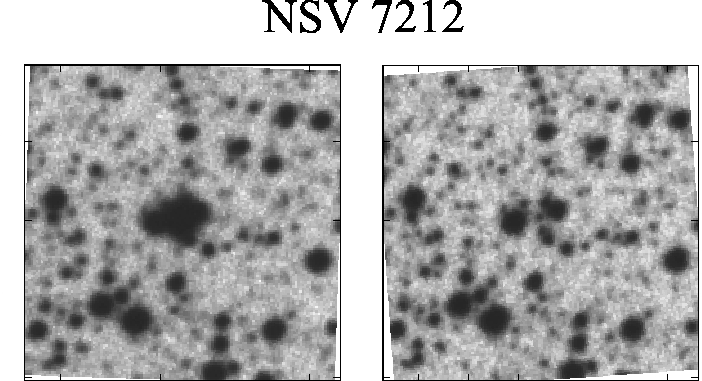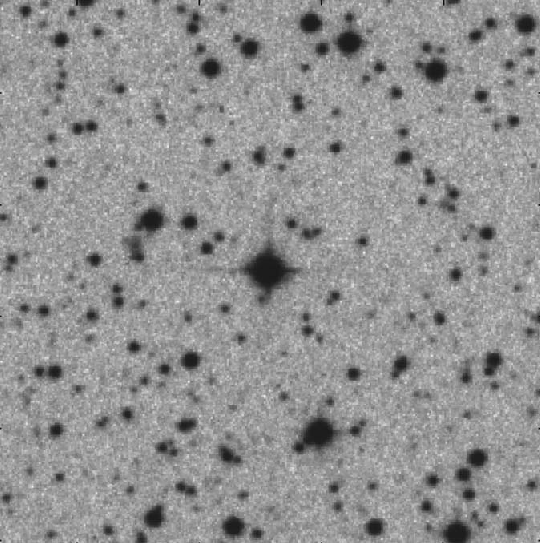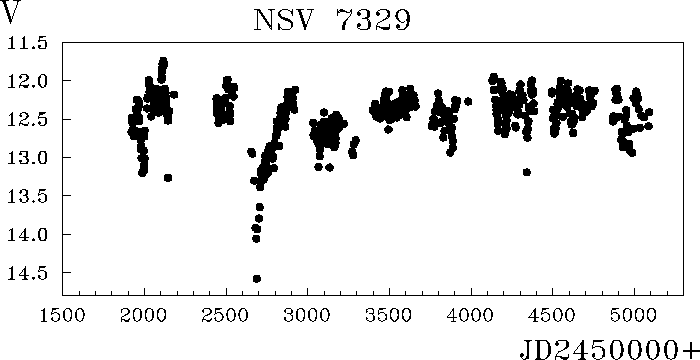Peremennye Zvezdy (Variable Stars) 31, No. 4, 2011
Received 1 September; accepted 15 September.
NSV 07212 and NSV 07329: Two Probable RCB Stars
E. V. Kazarovets[1], N. N. Samus[1,2]
- Institute of Astronomy, Russian Academy of Sciences,
Pyatnitskaya Str. 48, 119017 Moscow, Russia; e-mail:
helene@inasan.ru, samus@sai.msu.ru
- Sternberg Astronomical Institute, University Ave. 13, 119992 Moscow, Russia
Abstract:
1 Introduction
In the course of our work on new Name-Lists of the General Catalogue of Variable Stars (GCVS), we are undertaking attempts to find stars of the New Catalogue of Suspected Variables (the NSV catalog; Kukarkin et al. 1982) that had no reliable identifications and no accurate coordinates till now. Many stars found in this process have already obtained their permanent GCVS names in the recent Name-Lists (Kazarovets et al. 2008, 2011): after successful identification, it was possible to study them using observations from large CCD surveys of the sky available in the Internet. A part of the results from such studies were published separately, in several papers since 2009 (e.g., Kazarovets and Pastukhova 2011ab); other stars successfully found and studied just enter the Name-Lists with a reference to an unpublished study by the compilers.
From time to time, this process reveals especially interesting variable stars, deserving further detailed studies. In this paper, we announce two variables probably belonging to the rare RCB stars.
R Coronae Borealis (RCB) stars, named after their prototype, are
evolved stars with hydrogen-deficient, carbon-rich atmospheres.
From time to time, they exhibit deep fadings, sometimes as deep as
8-9 magnitudes. The deepest fadings can last for hundreds of
days. Thus, the prototype star, R CrB, an object of the sixth
visual magnitude at maximum light, is currently only beginning to
emerge from a fading to 15![]() that already lasts for more than
four years. Such fadings are usually interpreted as the result of
light absorption by dust produced by the star. Dust production
must be related to chemical peculiarities of these stars'
atmospheres. Dust-related are also infrared excesses observed for
typical RCB stars. Besides, variables of this type often exhibit
pulsations, their periods being of the order of a month.
that already lasts for more than
four years. Such fadings are usually interpreted as the result of
light absorption by dust produced by the star. Dust production
must be related to chemical peculiarities of these stars'
atmospheres. Dust-related are also infrared excesses observed for
typical RCB stars. Besides, variables of this type often exhibit
pulsations, their periods being of the order of a month.
2 NSV 07212
This variable was announced by Luyten (1935) as AN 409.1935 Nor;
its provisional Harvard designation is HV 8772. According to
Luyten, the star varied between 13.5![]() and 17.2
and 17.2![]() (photographic magntitudes). Later it entered several catalogs of
suspected variable stars (Prager 3952, CSV 2421, NSV 07212) but
did not get a permanent variable-star name because no particulars
on the character of variations and no finding chart had ever been
published.
(photographic magntitudes). Later it entered several catalogs of
suspected variable stars (Prager 3952, CSV 2421, NSV 07212) but
did not get a permanent variable-star name because no particulars
on the character of variations and no finding chart had ever been
published.
We identify the variable with the star GSC 08308-01266 (11![]() 4) =
IRAS 15407-5035, located in 1
4) =
IRAS 15407-5035, located in 1![]() 5 to the east of the position
published by Luyten. This is the only star around Luyten's
position that obviously varies. The difference between our
coordinates and those published by Luyten is within typical
positional uncertainties of Luyten's publications, as follows from
our many-year experience of search for his variables. The 2MASS
J2000.0 coordinates of our variable star are 15
5 to the east of the position
published by Luyten. This is the only star around Luyten's
position that obviously varies. The difference between our
coordinates and those published by Luyten is within typical
positional uncertainties of Luyten's publications, as follows from
our many-year experience of search for his variables. The 2MASS
J2000.0 coordinates of our variable star are 15![]() 44
44![]() 25
25![]() 077,
-50
077,
-50![]() 45
45![]() 01
01
![]() 21, and its 2MASS magnitudes,
21, and its 2MASS magnitudes, ![]() ,
,
![]() ,
, ![]() , suggest an infrared excess. The finding
chart is presented in Fig. 1. The star is contained in the General
Catalog of Galactic Carbon Stars (Alksnis et al. 2001) as
CGCS 3628; the spectral type R quoted there is from unpublished
data by C.B. Stephenson.
, suggest an infrared excess. The finding
chart is presented in Fig. 1. The star is contained in the General
Catalog of Galactic Carbon Stars (Alksnis et al. 2001) as
CGCS 3628; the spectral type R quoted there is from unpublished
data by C.B. Stephenson.
 |
The star enters the variable-star catalog of the ASAS-3 survey (Pojmanski 2002) as ASAS 154425-5045.1. It is listed as a MISC (miscellaneous) variable, i.e. an object with a somewhat indefinite variable-star classification; the period tabulated for it is 141.4 days. An inspection of the ASAS-3 light curve folded with this period shows that it is unable to satisfactorily reproduce the observations.
The light curve of the star, based on the ASAS-3 observations
available by mid-August, 2011 and covering the time range between
JD 2451920 and 2455110, is shown in Fig. 2. It is quite typical of
RCB variables. At maximum, the star is about 11![]() 8-11
8-11![]() 9
9![]() .
A single deep and broad minimum started between JD 2452922, when
the star had been still at 11
.
A single deep and broad minimum started between JD 2452922, when
the star had been still at 11![]() 9
9![]() , and JD 2453032, already at
12
, and JD 2453032, already at
12![]() 7
7![]() . At minimum, the star was fainter than 14
. At minimum, the star was fainter than 14![]()
![]() ; its
actual brightness at that time is unknown because of the presence
of companions (see below). After JD 2453180 (13
; its
actual brightness at that time is unknown because of the presence
of companions (see below). After JD 2453180 (13![]() 4
4![]() ), there is
a gap in observations till JD 2453387 (12
), there is
a gap in observations till JD 2453387 (12![]() 5
5![]() ), and it seems
that the recovery from the minimum lasted till about JD 2453600.
), and it seems
that the recovery from the minimum lasted till about JD 2453600.
Outside the minimum, there are also variations with an amplitude of several tenths of a magnitude. We were not able to represent these variations with a reliable period, but their timescale seems to be usual for RCB pulsations.
ASAS-3 magnitudes result from CCD photometry with a pixel size of
about ![]() . The images of the field available from the Aladin
Sky Atlas reveal the presence of at least two companions to the
star. The brighter of them (14
. The images of the field available from the Aladin
Sky Atlas reveal the presence of at least two companions to the
star. The brighter of them (14![]() 35
35![]() in the GSC 2.3 catalog) is
in
in the GSC 2.3 catalog) is
in ![]() from the variable, at the position angle of 100
from the variable, at the position angle of 100![]() . The
fainter one is probably at 15
. The
fainter one is probably at 15![]() ; its distance from the variable
is
; its distance from the variable
is ![]() and its position angle, 292
and its position angle, 292![]() . Thus, the variable's
magnitude at minimum brightness is seriously influenced, mainly by
the brighter companion. However, the fading and brightening rates
suggest that the minimum was not much fainter than 14
. Thus, the variable's
magnitude at minimum brightness is seriously influenced, mainly by
the brighter companion. However, the fading and brightening rates
suggest that the minimum was not much fainter than 14![]() .
.
The USNO Image and Catalog Archive
(http://www.nofs.navy.mil/data/FchPix/) provides five images of
the field taken with Schmidt telescopes in 1976-1995, two of them
in a broad blue band (J plates) and three, in a red band (IIIaF
plates). The first four plates show the variable bright. The fifth
plate, AO16588 (![]() band, emulsion Kodak IIIaF, filter OG590),
with the epoch 1995.2402, corresponding to JD 2452808, shows the
star extremely faint, probably as faint as 19
band, emulsion Kodak IIIaF, filter OG590),
with the epoch 1995.2402, corresponding to JD 2452808, shows the
star extremely faint, probably as faint as 19![]()
![]() , from a
comparison to surrounding USNO-A2.0 stars. We compare this image
to the plate AO15068 (epoch 1992.5599) in Fig. 3.
, from a
comparison to surrounding USNO-A2.0 stars. We compare this image
to the plate AO15068 (epoch 1992.5599) in Fig. 3.
 |
Though additional spectroscopy is desirable in order to check the hydrogen-deficient character of the star's spectrum, we conclude from the existing evidence that NSV 07212 is a bona fide large-amplitude RCB variable.
3 NSV 07329
NSV 07329 (AN 61.1914 Sco, Zinner 1171, CSV 2497) was announced,
among 49 variables, by Lampland (1914). His photographic
observations showed the star at 14![]() on June 25, 1913 and
fainter than 15
on June 25, 1913 and
fainter than 15![]() on June 28, 1913. Though Lampland promised to
prepare and publish finding charts for his stars, this was never
done. The coordinates he published for the new variables are
rough, and their reliable identification is a problem. If a
certain variable star is found within several arcminutes from
Lampland's position, it is usually identified with Lampland's
star. In 2008, we adopted the identification of NSV 07329 with the
variable star ASAS 155517-2924.6 (approximately in
on June 28, 1913. Though Lampland promised to
prepare and publish finding charts for his stars, this was never
done. The coordinates he published for the new variables are
rough, and their reliable identification is a problem. If a
certain variable star is found within several arcminutes from
Lampland's position, it is usually identified with Lampland's
star. In 2008, we adopted the identification of NSV 07329 with the
variable star ASAS 155517-2924.6 (approximately in ![]() from
Lampland's position) in the online version of the NSV catalog.
This is the only star in the ASAS variable-star catalog in wide
surroundings of the coordinates published by Lampland (1914). Our
checks of a number of other stars in the field has not revealed
any additional good candidates.
from
Lampland's position) in the online version of the NSV catalog.
This is the only star in the ASAS variable-star catalog in wide
surroundings of the coordinates published by Lampland (1914). Our
checks of a number of other stars in the field has not revealed
any additional good candidates.
In the ASAS variable-star catalog (Pojmanski 2002), the star
ASAS 155517-2924.6 is listed among MISC variables. Its 2MASS
coordinates are 15![]() 55
55![]() 17
17![]() 080, -29
080, -29![]() 24
24![]() 37
37
![]() 04
(J2000.0), and, like for NSV 07212, its 2MASS magnitudes
(
04
(J2000.0), and, like for NSV 07212, its 2MASS magnitudes
(![]() ,
, ![]() ,
, ![]() ) suggest an infrared excess. The
field is comparatively uncrowded. The finding chart is displayed
in Fig. 4.
) suggest an infrared excess. The
field is comparatively uncrowded. The finding chart is displayed
in Fig. 4.
 |
The ASAS period for ASAS 155517-2924.6, 435![]() 1, does not
provide a satisfactory representation of the ASAS-3 photometry.
The light curve from the ASAS-3 survey (Fig. 5) shows variations
in the 11
1, does not
provide a satisfactory representation of the ASAS-3 photometry.
The light curve from the ASAS-3 survey (Fig. 5) shows variations
in the 11![]() 8-(14
8-(14![]()
![]() range. It reveals a single deep minimum
that began between JD 24522548 (12
range. It reveals a single deep minimum
that began between JD 24522548 (12![]() 1
1![]() ) and 2452652
(12
) and 2452652
(12![]() 9
9![]() ), reached a magnitude below 14
), reached a magnitude below 14![]()
![]() at about 2452686,
with a subsequent ascent to about 12
at about 2452686,
with a subsequent ascent to about 12![]() 2
2![]() by JD 2452900.
Oscillations with a rather large amplitude were observed outside
this minimum. After JD 2454100, a pronounced cycle of 58
by JD 2452900.
Oscillations with a rather large amplitude were observed outside
this minimum. After JD 2454100, a pronounced cycle of 58![]() 4 can
be derived, with a peak-to-peak amplitude up to 0
4 can
be derived, with a peak-to-peak amplitude up to 0![]() 7.
7.
We are not aware of any publication concerning the spectral type of NSV 07329. The photometric information available suggests an RCB classification. The star could also belong to a subtype of young variable stars with deep fadings, but the field seems quite free of any nebulae. Spectroscopy of the star is very desirable.
4 Conclusions
We have identified the known carbon star NSV 07212 as an almost
certain RCB variable with a large variation amplitude, from
11![]() 8
8![]() to about 19
to about 19![]()
![]() . Two deep minima of the star have
been recorded so far.
. Two deep minima of the star have
been recorded so far.
NSV 07329 is a possible RCB variable, varying from 11![]() 8
8![]() to
fainter than 14
to
fainter than 14![]()
![]() . Only one deep minimum has been detected so
far.
. Only one deep minimum has been detected so
far.
High-quality spectroscopy is needed to finally establish the nature of these two interesting variable stars.
Acknowledgments: This study made extensive use of the ASAS data base, USNO Image and Catalog Archive, and Aladin Sky Atlas. Thanks are due to Dr. S.V. Antipin for his assistance. We gratefully acknowledge financial support from the program ``Origin and Evolution of Stars and Galaxies'' of the Presidium of Russian Academy of Sciences.
References:
Alksnis, A., Balklavs, A., Dzervitis, U., et al., 2001, Baltic Astronomy, 10, 1
Kazarovets, E. V. and Pastukhova, E. N., 2011a, Perem. Zvezdy Prilozhenie, 11, No. 7
Kazarovets, E. V. and Pastukhova, E. N., 2011b, Perem. Zvezdy Prilozhenie, 11, No. 29
Kazarovets, E. V., Samus, N. N., Durlevich, O. V., et al., 2008, Inform. Bull. Var. Stars, No. 5863
Kazarovets, E. V., Samus, N. N., Durlevich, O. V., et al., 2011, Inform. Bull. Var. Stars, No. 5969
Kukarkin, P. N., Kholopov, P. N., Artyukhina, N. M., et al., 1982, New Catalogue of Suspected Variable Stars, Moscow: ``Nauka''
Lampland, C. O., 1914, Astron. Nachr., 198, 351
Luyten, W.J., 1935, Astron. Nachr., 256, 325
Pojmanski, G., 2002, Acta Astron., 52, 397

